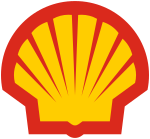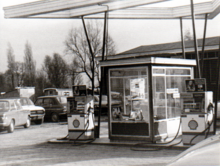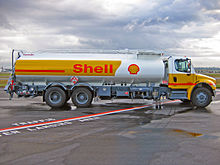
A | B | C | D | E | F | G | H | CH | I | J | K | L | M | N | O | P | Q | R | S | T | U | V | W | X | Y | Z | 0 | 1 | 2 | 3 | 4 | 5 | 6 | 7 | 8 | 9
It has been suggested that Shell WindEnergy be merged into this article. (Discuss) Proposed since April 2024. |
 Logo designed by Raymond Loewy | |
 Shell Centre headquarters in London | |
| Formerly | |
|---|---|
| Company type | Public |
| ISIN | GB00BP6MXD84 |
| Industry | |
| Predecessors |
|
| Founded | April 1907 (as Royal Dutch Shell) 20 July 2005 in Shell Centre, London (current entity) |
| Founders | |
| Headquarters | Shell Centre, , England |
Area served | Worldwide |
Key people |
|
| Products | |
| Brands |
|
| Revenue | |
| Total assets | |
| Total equity | |
Number of employees | 90,000 (2023)[4] |
| Divisions | |
| Subsidiaries | List
|
| Website | shell |
Footnotes / references
| |
Shell plc is a British multinational oil and gas company headquartered in London.[5] Shell is a public limited company with a primary listing on the London Stock Exchange (LSE) and secondary listings on Euronext Amsterdam and the New York Stock Exchange. A core component of Big Oil, Shell is the second largest investor-owned oil and gas company in the world by revenue (after ExxonMobil), and among the world's largest companies out of any industry.[6] Measured by both its own emissions, and the emissions of all the fossil fuels it sells, Shell was the ninth-largest corporate producer of greenhouse gas emissions in the period 1988–2015.
Shell was formed in April 1907 through the merger of Royal Dutch Petroleum Company of the Netherlands and The "Shell" Transport and Trading Company of the United Kingdom. The combined company rapidly became the leading competitor of the American Standard Oil and by 1920 Shell was the largest producer of oil in the world.[7] Shell first entered the chemicals industry in 1929. Shell was one of the "Seven Sisters" which dominated the global petroleum industry from the mid-1940s to the mid-1970s. In 1964, Shell was a partner in the world's first commercial sea transportation of liquefied natural gas (LNG).[8] In 1970, Shell acquired the mining company Billiton, which it subsequently sold in 1994 and now forms part of BHP. In recent decades gas has become an increasingly important part of Shell's business[9] and Shell acquired BG Group in 2016.[9]
Shell is vertically integrated and is active in every area of the oil and gas industry, including exploration, production, refining, transport, distribution and marketing, petrochemicals, power generation, and trading. Shell has operations in over 99 countries,[10] produces around 3.7 million barrels of oil equivalent per day and has around 44,000 service stations worldwide.[11][12] As of 31 December 2019, Shell had total proved reserves of 11.1 billion barrels (1.76×109 m3) of oil equivalent.[13] Shell USA, its principal subsidiary in the United States, is one of its largest businesses.[14] Shell holds 44%[15] of Raízen, a publicly-listed joint venture with Cosan, which is the third-largest Brazil-based energy company.[16] In addition to the main Shell brand, the company also owns the Jiffy Lube, Pennzoil and Quaker State brands.
Shell is a constituent of the FTSE 100 Index and had a market capitalisation of US$199 billion on 15 September 2022, the largest of any company listed on the LSE and the 44th-largest of any company in the world.[17] By 2021 revenues, Shell is the second-largest investor-owned oil company in the world (after ExxonMobil), the largest company headquartered in the United Kingdom, the second-largest company headquartered in Europe (after Volkswagen), and the 15th largest company in the world.[18] Until its unification in 2005 as Royal Dutch Shell plc, the firm operated as a dual-listed company, whereby the British and Dutch companies maintained their legal existence and separate listings but operated as a single-unit partnership. From 2005 to 2022, the company had its headquarters in The Hague, its registered office in London and had two types of shares (A and B). In January 2022, the firm merged the A and B shares, moved its headquarters to London, and changed its legal name to Shell plc.[5][19]
History
Origins



The Royal Dutch Shell Group was created in April 1907 through the amalgamation of two rival companies: the Royal Dutch Petroleum Company (Dutch: Koninklijke Nederlandse Petroleum Maatschappij) of the Netherlands and the Shell Transport and Trading Company Limited of the United Kingdom.[20] It was a move largely driven by the need to compete globally with Standard Oil.[21] The Royal Dutch Petroleum Company was a Dutch company founded in 1890 to develop an oilfield in Pangkalan Brandan, North Sumatra,[22] and initially led by August Kessler, Hugo Loudon, and Henri Deterding. The "Shell" Transport and Trading Company (the quotation marks were part of the legal name) was a British company, founded in 1897 by Marcus Samuel, 1st Viscount Bearsted, and his brother Samuel Samuel.[23] Their father had owned an antique company in Houndsditch, London,[24] which expanded in 1833 to import and sell seashells, after which the company "Shell" took its name.[20][25][26]
For various reasons, the new firm operated as a dual-listed company, whereby the merging companies maintained their legal existence but operated as a single-unit partnership for business purposes. The terms of the merger gave 60 percent stock ownership of the new group to Royal Dutch, and 40 percent to Shell. Both became holding companies for Bataafsche Petroleum Maatschappij, containing the production and refining assets, and Anglo-Saxon Petroleum Company, containing the transport and storage assets.[27] National patriotic sensibilities would not permit a full-scale merger or takeover of either of the two companies.[27] The Dutch company, Koninklijke Nederlandsche Petroleum Maatschappij at The Hague, was in charge of production and manufacture.[28] The British Anglo-Saxon Petroleum Company was based in London, to direct the transport and storage of the products.[28][26]
In 1912, Royal Dutch Shell purchased the Rothschilds' Russian oil assets in a stock deal. The Group's production portfolio then consisted of 53 percent from the East Indies, 29 percent from the Russian Empire, and 17 percent from Romania.[26][29]
20th century

During the First World War, Shell was the main supplier of fuel to the British Expeditionary Force.[30] It was also the sole supplier of aviation fuel and supplied 80 percent of the British Army's TNT.[30] It also volunteered all of its shipping to the British Admiralty.[30]
The German invasion of Romania in 1916 saw 17% of the group's worldwide production destroyed.[30] In 1919, Shell took control of the Mexican Eagle Petroleum Company and in 1921 formed Shell-Mex Limited, which marketed products under the "Shell" and "Eagle" brands in the United Kingdom. During the Genoa Conference of 1922 Royal Dutch Shell was in negotiations for a monopoly over Soviet oilfields in Baku and Grosny, although the leak of a draft treaty led to breakdown of the talks.[31] In 1929, Shell Chemicals was founded.[30] By the end of the 1920s, Shell was the world's leading oil company, producing 11 percent of the world's crude oil supply and owning 10 percent of its tanker tonnage.[30]
During the Spanish Civil War the company sold oil to the Nationalist side of Francisco Franco.[32]

Located in the north bank of the River Thames in London, Shell Mex House was completed in 1931, and was the head office for Shell's marketing activity worldwide.[30] In 1932, partly in response to the difficult economic conditions of the Great Depression, Shell-Mex merged its UK marketing operations with those of BP (British Petroleum) to create Shell-Mex & BP,[33] a company that traded until the brands separated in 1975. Royal Dutch Company ranked 79th among United States corporations in the value of World War II military production contracts.[34]

The 1930s saw Shell's Mexican assets seized by the local government.[30] After the invasion of the Netherlands by Nazi Germany in 1940, the head office of the Dutch companies was moved to Curaçao.[30] In 1945, Shell's Danish headquarters in Copenhagen, at the time being used by the Gestapo, was bombed by Royal Air Force De Havilland Mosquitoes in Operation Carthage.[35]
In 1937, Iraq Petroleum Company (IPC), 23.75 percent owned by Royal Dutch Shell plc,[36] signed an oil concession agreement with the Sultan of Muscat. In 1952, IPC offered financial support to raise an armed force that would assist the Sultan in occupying the interior region of Oman, an area that geologists believed to be rich in oil. This led to the 1954 outbreak of the Jebel Akhdar War in Oman that lasted for more than 5 years.[37]

Around 1952, Shell was the first company to purchase and use a computer in the Netherlands.[38] The computer, a Ferranti Mark 1*, was assembled and used at the Shell laboratory in Amsterdam. In 1970, Shell acquired the mining company Billiton, which it subsequently sold in 1994.[39]
In the 1990s, protesters criticised the company's environmental record, particularly the possible pollution caused by the proposed disposal of the Brent Spar platform into the North Sea. Despite support from the UK government, Shell reversed the decision under public pressure but maintained that sinking the platform would have been environmentally better.[40] Shell subsequently published an unequivocal commitment to sustainable development, supported by executive speeches reinforcing this commitment.[41] Shell was subsequently criticised by the European Commission and five European Union members after deciding to leave part of its decommissioned oil rigs standing in the North Sea. Shell argued that removing them would be too costly and risky. Germany said that the estimated 11,000 tonnes of raw oil and toxins remaining in the rigs would eventually seep into the sea, and called it a 'ticking timebomb'.[42]
On 15 January 1999, off the Argentinian town of Magdalena, Buenos Aires, the Shell tanker Estrella pampeana collided with a German cargo ship, emptying its contents into the lake, polluting the environment, drinkable water, plants and animals. Over a decade after the spill, a referendum held in Magdalena determined the acceptance of a US$9.5 million compensatory payout from Shell.[43] Shell denied responsibility for the spill, but an Argentine court ruled in 2002 that the corporation was responsible.[44]
21st century


In 2002, Shell acquired Pennzoil-Quaker State through its American division for $22 USD per share, or about $1.8 billion USD. Through its acquisition of Pennzoil, Shell became a descendant of Standard Oil. With its acquisition, Shell inherited multiple auto part brands including Jiffy Lube, Rain-X, and Fix-a-Flat. The company was notably late in its acquisition as seen by journalists, with Shell seen as streamlining its assets around the same time of other major mergers and acquisitions in the industry, such as BP's purchase of Amoco and the merger of Exxon and Mobil.[45]
In 2004, Shell overstated its oil reserves, resulting in loss of confidence in the group, a £17 million fine by the Financial Services Authority and the departure of the chairman Philip Watts. A lawsuit resulted in the payment of $450 million to non-American shareholders in 2007.[46][47][48]
As a result of the scandal, the corporate structure was simplified. Two classes of ordinary shares, A (code RDSA) and B (code RDSB), identical but for the tax treatment of dividends, were issued for the company.[49]

In November 2004, following a period of turmoil caused by the revelation that Shell had been overstating its oil reserves, it was announced that the Shell Group would move to a single capital structure, creating a new parent company to be named Royal Dutch Shell plc, with its primary listing on the LSE, a secondary listing on Euronext Amsterdam, its headquarters and tax residency in The Hague, Netherlands and its registered office in London. The company was already incorporated in 2002 as Forthdeal Limited, a shelf corporation incorporated by Swift Incorporations Limited and Instant Companies Limited, both based in Bristol.[19] The unification was completed on 20 July 2005 and the original owners delisted their companies from the respective exchanges. On 20 July 2005, the Shell Transport & Trading Company plc was delisted from the LSE,[50] whereas, Royal Dutch Petroleum Company from the New York Stock Exchange on 18 November 2005.[51] The shares of the company were issued at a 60/40 advantage for the shareholders of Royal Dutch in line with the original ownership of the Shell Group.[52]
During the 2009 Iraqi oil services contracts tender, a consortium led by Shell (45%) and which included Petronas (30%) was awarded a production contract for the "Majnoon field" in the south of Iraq, which contains an estimated 12.6 billion barrels (2.00×109 m3) of oil.[53][54] The "West Qurna 1 field" production contract was awarded to a consortium led by ExxonMobil (60%) and included Shell (15%).[55]
In February 2010, Shell and Cosan formed a 50:50 joint-venture, Raízen, comprising all of Cosan's Brazilian ethanol, energy generation, fuel distribution and sugar activities, and all of Shell's Brazilian retail fuel and aviation distribution businesses.[56] In March 2010, Shell announced the sale of some of its assets, including its liquefied petroleum gas (LPG) business, to meet the cost of a planned $28bn capital spending programme. Shell invited buyers to submit indicative bids, due by 22 March, with a plan to raise $2–3bn from the sale.[57] In June 2010, Shell agreed to acquire all the business of East Resources for a cash consideration of $4.7 billion. The transaction included East Resources' tight gas fields.[58]
Over the course of 2013, the corporation began the sale of its US shale gas assets and canceled a US$20 billion gas project that was to be constructed in the US state of Louisiana. A new CEO Ben van Beurden was appointed in January 2014, prior to the announcement that the corporation's overall performance in 2013 was 38 percent lower than in 2012—the value of Shell's shares fell by 3 percent as a result.[59] Following the sale of the majority of its Australian assets in February 2014, the corporation plans to sell a further US$15 billion worth of assets in the period leading up to 2015, with deals announced in Australia, Brazil and Italy.[60]
Shell announced on 8 April 2015 it had agreed to buy BG Group for £47 billion (US$70 billion), subject to shareholder and regulatory approval.[61] The acquisition was completed in February 2016, resulting in Shell surpassing Chevron Corporation and becoming the world's second largest non-state oil company.[62]
On 7 June 2016, Shell announced that it would build an ethane cracker plant near Pittsburgh, Pennsylvania, after spending several years doing an environmental cleanup of the proposed plant's site.[63]
In January 2017, Shell agreed to sell £2.46bn worth of North Sea assets to oil exploration firm Chrysaor.[64] In 2017, Shell sold its oil sands assets to Canadian Natural Resources in exchange of approximately 8.8% stake in that company. In May 2017, it was reported that Shell plans to sell its shares in Canadian Natural Resources fully exiting the oil sands business.[65]
On 5 November 2017, the Paradise Papers, a set of confidential electronic documents relating to offshore investment, revealed that Argentine Energy Minister Juan José Aranguren was revealed to have managed the offshore companies 'Shell Western Supply and Trading Limited' and 'Sol Antilles y Guianas Limited', both subsidiaries of Shell. One is the main bidder for the purchase of diesel oil by the government through the state owned CAMMESA (Compañía Administradora del Mercado Mayorista Eléctrico).[66]
On 30 April 2020, Shell announced that it would cut its dividend for the first time since the Second World War, due to the oil price collapse following the reduction in oil demand during the COVID-19 pandemic. Shell stated that their net income adjusted for the cost of supply dropped to US$2.9 billion in three months to 31 March. This compared with US$5.3 billion in the same period the previous year.[67] On 30 September 2020, the company said that it would cut up to 9,000 jobs as a result of the economic effects caused by the pandemic and announced a "broad restructuring".[68] In December 2020, Shell forecast another write-down of $3.5-4.5 billion for the fourth quarter due to lower oil prices, following $16.8 billion of impairment in the second quarter.[69]
In February 2021, Shell announced a loss of $21.7 billion in 2020 due to the COVID-19 pandemic,[70] despite reducing its operating expenses by 12%, or $4.5 billion, according to a Morningstar analysis cited by Barron's.[71][72]
In November 2021, Shell announced that it is planning to relocate their headquarters to London, abandon its dual share structure, and change its name from Royal Dutch Shell plc to Shell plc.[73] The company's name change was registered in the Companies House on 21 January 2022.[19]
In December 2021, Shell pulled out of the Cambo oil field, off the Shetland Islands, claiming that "the economic case for investment in this project is not strong enough at this time, as well as having the potential for delays". The proposed oilfield had been the subject of intense campaigning by environmentalists in the run-up to the COP26 UN climate summit in Glasgow in November 2021.[74]
On 4 March 2022, during the Russian invasion of Ukraine and in the midst of the growing boycott of Russian economy and related divestments, Shell bought a cargo of discounted Russian crude oil.[75] The next day, following criticism from Ukraine's Foreign Minister Dmytro Kuleba, Shell defended the purchase as a short term necessity, but also announced that it intended to reduce such purchases, and it would put profits from any Russian oil it purchases into a fund that would go towards humanitarian aid to Ukraine.[76] On 8 March, Shell announced that it would stop buying Russian oil and gas and close its service stations in the country.[77]
In 2022, the major oil and gas companies, including Shell,[78] reported sharp rises in interim revenues and profits.[79] In fact, this rise in profit for Shell was so sharp, that 2022 was the company's best year, as Shell recorded double the profits from 2021, and the highest profit in its entire history.[80]
Corporate affairs
| Company | Revenue (USD)[81] | Profit (USD) | Brands |
|---|---|---|---|
| ExxonMobil | $286 billion | $23 billion | Mobil Esso Imperial Oil |
| Shell plc | $273 billion | $20 billion | Jiffy Lube Pennzoil |
| TotalEnergies | $185 billion | $16 billion | Elf Aquitaine SunPower |
| BP | $164 billion | $7.6 billion | Amoco Aral AG |
| Chevron | $163 billion | $16 billion | Texaco Caltex Havoline |
| Marathon | $141 billion | $10 billion | ARCO[82] |
| Phillips 66 | $115 billion | $1.3 billion | 76 Conoco JET |
| Valero | $108 billion | $0.9 billion | — |
| Eni | $77 billion | $5.8 billion | — |
| ConocoPhillips | $48.3 billion | $8.1 billion | — |
Business trends
The key trends of Shell are (as at the financial year ending 31 December):[83]
| Year | Revenue (US$ bn) | Net income (US$ bn) | Employees |
|---|---|---|---|
| 2017 | 305 | 12.9 | 86.000 |
| 2018 | 388 | 23.3 | 82.000 |
| 2019 | 344 | 15.8 | 83.000 |
| 2020 | 180 | –21.6 | 87.000 |
| 2021 | 261 | 20.1 | 82.000 |
| 2022 | 381 | 42.3 | 87.000 |
| 2023 | 316 | 19.3 | 87.000 |
Management
On 4 August 2005, the board of directors announced the appointment of Jorma Ollila, chairman and CEO of Nokia at the time, to succeed Aad Jacobs as the company's non-executive chairman on 1 June 2006. Ollila is the first Shell chairman to be neither Dutch nor British. Other non-executive directors include Maarten van den Bergh, Wim Kok, Nina Henderson, Lord Kerr, Adelbert van Roxe, and Christine Morin-Postel.[84]
Since 3 January 2014, Ben van Beurden has been CEO of Shell.[59] His predecessor was Peter Voser who became CEO of Shell on 1 July 2009.[85]
Following a career at the corporation, in locations such as Australia and Africa, Ann Pickard was appointed as the executive vice president of the Arctic at Royal Dutch Shell, a role that was publicized in an interview with McKinsey & Company in June 2014.[86]
In January 2023, Wael Sawan succeeded Ben van Beurden as CEO.[87]
Historical leadership
Name and logo
The name Shell is linked to The "Shell" Transport and Trading Company.[88] In 1833, the founder's father, Marcus Samuel Sr., founded an import business to sell seashells to London collectors. When collecting seashell specimens in the Caspian Sea area in 1892, the younger Samuel realised there was potential in exporting lamp oil from the region and commissioned the world's first purpose-built oil tanker, the Murex (Latin for a type of snail shell), to enter this market; by 1907 the company had a fleet. Although for several decades the company had a refinery at Shell Haven on the Thames, there is no evidence of this having provided the name.[89]
The Shell logo is one of the most familiar commercial symbols in the world. This logo is known as the "pecten" after the sea shell Pecten maximus (the giant scallop), on which its design is based. The yellow and red colours used are thought[90] to relate to the colours of the flag of Spain, as Shell built early service stations in California, previously a Spanish colony. The current revision of the logo was designed by Raymond Loewy in 1971.[91]
The slash was removed from the name "Royal Dutch/Shell" in 2005, concurrent with moves to merge the two legally separate companies (Royal Dutch and Shell) to the single legal entity which exists today.[92]
On 15 November 2021, Royal Dutch Shell plc announced plans to change its name to Shell plc.[93]
Logo evolution
-
1900–04
-
1904–09
-
1909–30
-
1930–48
-
1948–55
-
1955–70
-
1971–present







